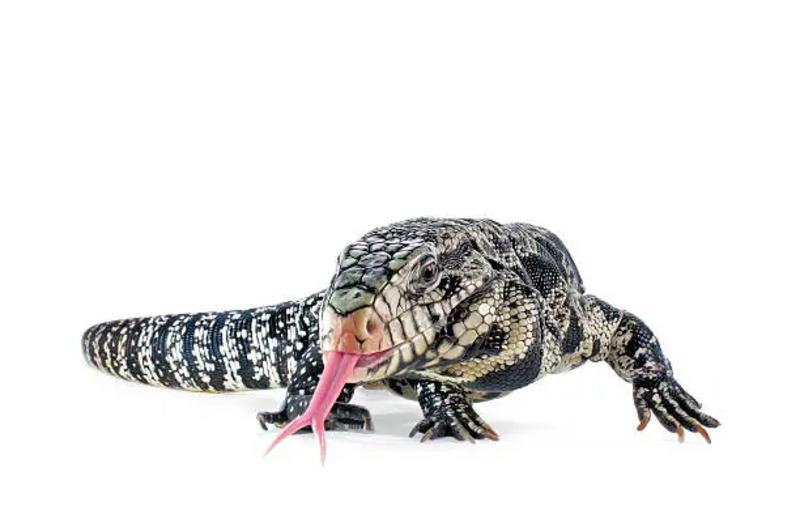
Tegu Lizard as Pets
Published on June 26, 2025
Tegu lizards, particularly the Argentine Black and White Tegu, have gained significant popularity in the exotic pet trade due to their impressive size, striking appearance, and surprising intelligence. These large, omnivorous lizards can become quite docile and even bond with their owners, making them a captivating choice for experienced reptile enthusiasts. However, owning a Tegu is a substantial commitment that requires extensive research, a significant investment in proper housing, and a dedication to their long-term care.
This comprehensive guide will explore the realities of Tegu ownership, helping you determine if you're prepared for the unique challenges and rewards of keeping these magnificent reptiles.
Are Tegus the Right Pet for You?
Tegus are not beginner reptiles. Their needs are complex, and their size demands considerable space. They are best suited for owners who are prepared for:
- Large Size: Adult Tegus can reach 3-4 feet in length, with some males exceeding 4 feet.
- Long Lifespan: With proper care, Tegus can live 15-20 years, or even longer. This is a long-term commitment.
- Significant Enclosure Requirements: They need very large, custom-built enclosures.
- Specific Environmental Needs: Precise temperature, humidity, and lighting are crucial.
- Varied Diet: They are omnivores with diverse dietary needs.
- Intelligence and Personality: They are intelligent and can develop distinct personalities, requiring mental stimulation and consistent interaction.
1. Enclosure: Size Matters Immensely
The enclosure is arguably the most critical aspect of Tegu care. A juvenile Tegu can start in a 40-gallon breeder tank, but they grow rapidly. An adult Tegu requires a minimum enclosure size of 8 feet long x 4 feet wide x 4 feet high. Many owners opt for custom-built enclosures or converted sheds.
- Substrate: A deep layer (at least 12-18 inches) of a substrate mix like cypress mulch, coco fiber, or organic topsoil is essential for burrowing and maintaining humidity.
- Hides: Provide multiple secure hides where your Tegu can feel safe and sleep.
- Climbing & Enrichment: Sturdy branches, rocks, and other decor for climbing and mental stimulation.
2. Heating and Lighting: Creating a Microclimate
Tegus are diurnal (active during the day) and require a strong thermal gradient and UVB lighting.
- Basking Spot: A basking surface temperature of 100-110°F (38-43°C) is crucial for digestion. Use a high-wattage basking bulb.
- Ambient Temperature: A cool side of 75-80°F (24-27°C) and a warm side of 85-90°F (29-32°C). Nighttime temperatures can drop to 70-75°F (21-24°C).
- UVB Lighting: A high-output linear UVB bulb (e.g., T5 HO 10.0 or 12.0) spanning 2/3 to 3/4 of the enclosure is absolutely essential for calcium metabolism and overall health. It should be on for 10-12 hours a day.
- Humidity: Maintain 70-80% humidity. This can be achieved through deep substrate, misting, and a large water bowl.
3. Diet: Omnivorous and Varied
Tegus are omnivores, and their diet should be highly varied to ensure complete nutrition. Juveniles eat more protein, while adults consume a more balanced mix.
- Protein Sources: Crickets, dubia roaches, superworms, hornworms, silkworms, high-quality whole prey (frozen/thawed mice, chicks - sparingly).
- Fruits & Vegetables: Collard greens, mustard greens, dandelion greens, bell peppers, squash, berries, melon. Avoid citrus and avocado.
- Supplements: Dust food with a calcium supplement (with D3) daily for juveniles and 3-4 times a week for adults. A multivitamin should be used 1-2 times a week.
4. Hydration: Always Available
Provide a large, sturdy water bowl that your Tegu can easily climb into and out of. They often defecate in their water, so it needs to be cleaned and refilled daily.
5. Handling and Socialization
Tegus can become very tame with consistent, gentle handling from a young age. Regular interaction builds trust. They are intelligent and can recognize their owners. However, they are powerful animals, and proper handling techniques are essential for safety.
6. Brumation (Winter Dormancy)
Many Tegus will naturally brumate (a reptile equivalent of hibernation) during cooler months. This is a natural process, but it requires specific temperature and light cycles. Research this thoroughly if your Tegu shows signs of brumation.
7. Veterinary Care
Find a veterinarian experienced with exotic reptiles before you acquire a Tegu. Regular check-ups are essential, and they can advise on proper diet, supplements, and any health concerns.
Conclusion
Tegu lizards are magnificent, intelligent, and rewarding pets for those who can meet their demanding care requirements. Their impressive size and engaging personalities make them truly unique companions. However, their long lifespan and need for extensive, specialized housing mean they are a serious, long-term commitment. Ensure you are fully prepared before bringing one of these incredible reptiles into your home.